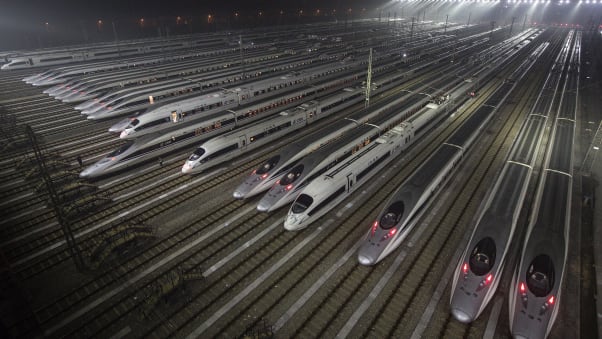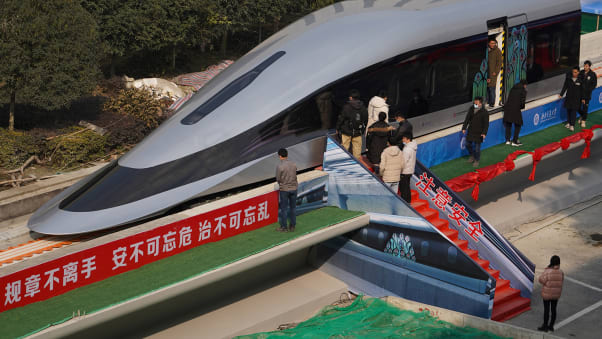Courtesy : edition.cnn.com(CNN) — At the beginning of the 21st century China had no high-speed railways.Slow and often uncomfortable trains plodded across this vast country, with low average speeds making journeys such as Shanghai-Beijing a test of travel endurance. Today, it’s a completely different picture. The world’s most populous nation has — by some distance — the world’s largest network of high-speed railways.No fewer than 37,900 kilometers (about 23,500 miles) of lines crisscross the country, linking all of its major mega-city clusters, and all have been completed since 2008.Related contentChina debuts train prototype that can hit speeds of 620 kilometers per hourHalf of that total has been completed in the last five years alone, with a further 3,700 kilometers due to open in the coming months of 2021.The network is expected to double in length again, to 70,000 kilometers, by 2035. With maximum speeds of 350 kph (217 mph) on many lines, intercity travel has been transformed and the dominance of airlines has been broken on the busiest routes.By 2020, 75% of Chinese cities with a population of 500,000 or more had a high-speed rail ink.Spain, which has Europe’s most extensive high-speed network and occupies second place in the global league table, is a minnow in comparison with just over 2,000 miles of dedicated lines built for operation at over 250 kph.In contrast, the UK currently has just 107 kilometers while the United States has only one rail route that (just about) qualifies for high-speed status — Amtrak’s North East Corridor, where Acela trains currently top out at 240 kph on expensively rebuilt sections of existing line shared with commuter and freight trains.
A symbol of economic power
China’s ambition is to make high-speed rail the mode of choice for domestic long-distance travel, but these new railways have a much greater significance.Much like Japan’s Shinkansen in the 1960s, they are a symbol of the country’s economic power, rapid modernization, growing technological prowess and increasing prosperity.For China’s ruling Communist Party and its leader Xi Jinping, high-speed rail is also a powerful tool for social cohesion, political influence and the integration of disparate regions with distinct cultures into the mainstream.“The building of these new railways forms part of Xi Jinping’s grand plan of ‘integrating the vast national market,'” says Dr. Olivia Cheung, research fellow at the China Institute of the University of London’s School of Oriental and African Studies (SOAS). “It is also meant to be reflective of his ‘new development philosophy,’ of which ‘coordinated development’ is a key concept.”His scheme is grand in that it extends beyond just simply connecting existing towns, but existing towns with new mega-towns that are being constructed from scratch. A famous example in which Xi takes a lot of pride is the Xiong’an New Area in Hebei province, around 60 miles southwest of Beijing.”In that sense, it could be argued that China is repeating railway history; many early railways in North America, Europe and the colonies of the European empires were built with similar goals.The development of railway networks in Russia — most notably the Trans-Siberian Railway — Prussia, France, Italy and the British Empire, among others, were strongly influenced by political and military demands as well as economic development.However, what took decades in the 19th and early 20th centuries is being achieved in just a few years by China.

With 37,900 kilometers of lines, China has the world’s largest network of high-speed railways.Wang He/Getty Images AsiaPac/Getty Images”The Chinese have created an entire high-speed rail network on an unprecedented scale — often faster and certainly more reliable than Chinese domestic flights,” says rail travel expert Mark Smith, better known as “The Man in Seat 61.”“It’s hard not to be impressed by the sheer size of some of the new stations, and by the efficiency with which the system moves vast numbers of people, all with a reserved seat and increasingly without the need for paper tickets, just a scan of an ID card or passport at the ticket gates.”Related contentHow Europe’s night trains came back from the deadChina initially relied on high-speed technology imported from Europe and Japan to establish its network. Global rail engineering giants such as Bombardier, Alstom and Mitsubishi were understandably keen to co-operate, given the potential size of the new market and China’s ambitious plans.However, over the last decade, it is domestic companies that have developed into world leaders in high-speed train technology and engineering, thanks to the astonishing expansion of their home network.
Overcoming high-speed growing pains
The sheer size of China and its tremendous variations in terrain, geology and climate have presented the country’s railway engineers with incredible challenges.From sometimes frozen Harbin in the far north to the near-tropical humidity of the Pearl River Delta megalopolis, to the 1,776-km Lanzhou-Urumqi line traversing the Gobi Desert, China’s engineers have quickly developed extensive expertise in driving railways over, under and through whatever terrain lies in their path.That rapid growth has not been without its problems though; while centralized state funding, planning and approval allows China to avoid the endless legal wrangles that have bedeviled projects in Europe and the United States for decades, the flip side is that new lines pay little heed to existing communities along their route.China’s high-speed growing pains also contributed to the tragic Wenzhou collision in July 2011, when two trains collided on a viaduct and derailed, sending four coaches to the floor below, killing 40 passengers and injuring almost 200 others.Public confidence in high-speed rail was severely shaken by the accident, resulting in a blanket speed reduction and the suspension of construction work on new lines pending an official investigation. However, no major incidents have been reported in the decade since and passenger numbers have risen exponentially as the network has expanded.For anyone used to the scope of traditional railway projects, the statistics are often mind boggling.Construction of the 815-kilometer, $13.5 billion Zhengzhou East-Wangzhou line was completed in less than five years.When the new 180-kilometer Xuzhou-Lianyungang line opened in February, it completed a continuous 3,490-kilometer high-speed rail connection between Jiangsu province and Urumqi, in the Xinjiang Uighur Autonomous Region. Heading north from the capital, trains now complete the 1,700-kilometer Beijing-Harbin journey in just five hours — requiring an average speed of 340 kph.By late-2020, China National Railways was operating more than 9,600 high-speed trains per day, including the world’s only high-speed overnight sleeper services on selected longer-distance routes.On some routes, more than 80% of the track is elevated, soaring above densely packed cities and valuable agricultural land on endless concrete viaducts. More than 100 tunnels — each over 10 kilometers — have also been bored, along with spectacular long-span bridges thrown over natural obstacles such as the Yangtze River.
A high-tech demonstration in efficiency
Not satisfied with pushing the boundaries of speed, endurance and civil engineering, Chinese companies are among the first in the world to introduce new technology such as autonomous (driverless) train operation and advanced signaling and control technology.The driverless “bullet trains” connecting Beijing and Zhangjiakou in northern Hebei province are capable of hitting speeds up to 350 kph, making them the world’s fastest autonomous trains.The new route, opened in December 2019 as part of preparations for the Beijing 2022 Winter Olympic and Paralympic Games, has reduced travel time for the 174-kilometer journey from three hours to less than 60 minutes. The fastest trains complete the trip in just 45 minutes.

No cold platforms here. A passenger waits to board their train at a high-speed railway station in Shanghai.Lintao Zhang/Getty Images AsiaPac/Getty ImagesBuilt in just four years, the line has 10 stations serving two of the major Winter Games venues, plus another at Badaling Changcheng providing faster access for tourists to the Great Wall of China. The latter is the world’s deepest high-speed railway station, situated 102 meters (335 feet) underground.Passenger saloons on the autonomous trains have expanded storage areas for winter sports equipment, seats with 5G touchscreen control panels, intelligent lighting, thousands of safety sensors and removable seats for passengers in wheelchairs. Facial-recognition technology and robots are used in stations to assist travelers with navigation, luggage and check-in.Enormous new stations serving the major cities on the high-speed network are more reminiscent of airport terminals, with acres of spotless polished marble and glass, enormous information screens and lounges where passengers are held until their train is called. No loitering on cold and windy platforms here!Related contentChina debuts bullet train that can operate in extremely cold temperatures“While the UK argues about building High Speed 2, China has created a nationwide high-speed network,” says rail expert Smith.”China’s high-speed lines are ruthlessly efficient — once booked, a swipe of your ID card or passport at the ticket gates is all you need to travel.”Fares, he says, start from as little as $13.The new Olympic line gives some clues as to the future direction of rail travel in China — and beyond — but technological boundaries are also being pushed in other areas.In late-2020, China’s state-owned rail engineering colossus CRRC previewed the prototype of a very high-speed electric train for international routes capable of operating at speeds as high as 400 kph.Not only is it claimed to operate in temperatures ranging between -50C and +50C, it features newly developed gauge changing wheelsets that will allow it to run direct into Russia, Mongolia and Kazakhstan, which use a wider track gauge than China’s standard 1,435 mm. More ambitiously, the ability to change gauges could also create the possibility for direct trains to India and Pakistan via Myanmar and Bangladesh.
What comes next?
Expansion into neighboring countries is already underway with the $5.3 billion Laos-China Railway due to open by the end of 2021. Although not a high-speed railway, the new 257-mile line is a significant extension of Chinese railway influence, providing improved links from southern China to the Laotian capital Vientiane.Construction of a railway to Bangkok in Thailand and eventually south to Singapore is also in progress.CRRC is already the world’s largest supplier of railway vehicles and technology but as its home market matures, it has its eyes firmly on global exports worth billions of dollars every year.As China seeks to expand its influence across Asia and into Europe and Africa via the ambitious “Belt and Road Initiative,” rail is playing a fundamental part in creating the new “Silk Road” it desires.

In January, China revealed a prototype for a new high-speed Maglev train that is capable of reaching speeds of 620 kilometers (385 miles) per hour.STR/AFP/Getty Images”China’s high-speed rail industry has become one of the nation’s economic pillar industries and the high-speed network has brought greater mobility and prosperity to the public,” said president of Bombardier Transportation China, Jianwei Zhang, in a 2020 statement.Proposed new railways crossing the Himalayas to India and Pakistan, or reaching into Russia and the former Soviet states of the Central Asian republics will not only provide improved trade routes for Chinese exports, but will deliver enormous contracts (and challenges) for the country’s rail and civil engineering conglomerates.Backed by investment funds and loans, these projects also strengthen China’s position as the regional superpower, further pulling developing nations into its gravitational field by increasing their economic dependence on Beijing.Related contentJapan debuts new bullet train that can run during an earthquake“What remains to be seen — and it will be very interesting indeed to know — is how Beijing will systematically link up the domestic railway networks with the Belt and Road Initiative,” says Cheung.”BRI is an ambitious, comprehensive and sophisticated grand strategy, but suspicions about China’s intentions are on the rise.”The challenges to the BRI have not been talked about in public, including how a number of countries are scaling back, suspending or canceling their BRI contracts signed with China. They are worried of the possibility of losing control over strategic assets in the case of defaulting payment of Chinese loans.”Nevertheless, November 2020 saw the unveiling of a proposed $48 billion, 965-kilometer link between Chengdu, the provincial capital of Sichuan, and western Tibet close to the Indian border. An extension of the existing Lhasa-Xigaze railway, opened in 2014, is thought to be a precursor to a planned line to Kathmandu in Nepal and beyond.These moves are viewed with suspicion in India, China’s biggest regional and economic rival, adding to an already tense situation where their borders meet.Related contentAmerica’s Amtrak moment could finally be hereAlthough its trains are now among the fastest in the world, China is also spending billions of dollars on maglev (magnetic levitation) technology, which will allow it to operate passenger services at up to 620 kph — well beyond the current limits of steel wheels on steel rails.Two lines are currently under construction totaling around 170 miles, Shanghai-Hangzhou in Zhejiang province and a 110-kilometer underground route linking Guangzhou and Shenzhen, the two biggest cities in the densely populated Pearl River Delta region. It is expected that the latter will eventually extend to Kowloon in the former British territory of Hong Kong.These projects build on experience gained with the German-backed Shanghai Airport maglev line, which opened in 2003, and is currently the only line of its kind in public operation.Taking a typically pragmatic approach to raising the speed of land transport, China sees maglev as a better option than the much hyped, but unproven Hyperloop for bridging the gap between high-speed rail and air on long-distance routes.




